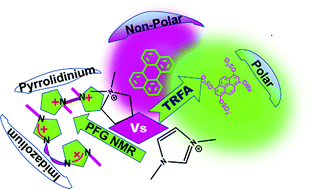Comparison between pyrrolidinium-based and imidazolium-based dicationic ionic liquids: intermolecular interaction, structural organization, and solute dynamics†
Abstract
With an aim to understand the difference in the behaviour of imidazolium and pyrrolidinium-based dicationic ionic liquids (DILs) in terms of the intermolecular interactions, microscopic-structure and dynamics, two DILs, the imidazolium-based 1,9-bis(3-methylimidazolium-1-yl)nonane bis(trifluoromethanesulfonyl)imide and the pyrrolidinium-based 1,9-bis(1-methylpyrrolidinium-1-yl)nonane bis(trifluoromethanesulfonyl)imide, have been synthesized and subsequently investigated by exploiting combined steady sate and time resolved fluorescence, electron paramagnetic resonance (EPR) and nuclear magnetic resonance (NMR) spectroscopic techniques. Data obtained for DILs have also been compared with their corresponding mono-cationic counterpart (MILs) to evaluate and understand the distinctive characteristics of the DILs in contrast with the corresponding MILs. Steady state emission and EPR data have revealed that the pyrrolidinium-based DIL is slightly less polar than the imidazolium-based DIL. Temperature-dependent fluorescence anisotropy decay of two probes, perylene and MPTS (8-methoxypyrene-1,3,6-trisulfonate), has been measured in DILs as well as in MILs. Solute–solvent coupling constants obtained from the experimentally measured rotational correlation times with the aid of Stokes–Einstein–Debye hydrodynamic theory have indicated appreciable differences in the dynamics of both the solutes on going from MILs to DILs. More interestingly, the outcome of the NMR study has suggested that the alkyl spacer chain in the imidazolium-based DIL exists in the folded form, but the pyrrolidinium-based DIL remains in the straight chain conformation. Inherently, the outcomes of all of these studies have depicted that the microscopic structural organisations in imidazolium and pyrrolidinium-based DILs are different from each other as well as from their respective mono-cationic counterparts.



 Please wait while we load your content...
Please wait while we load your content...